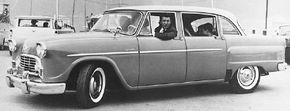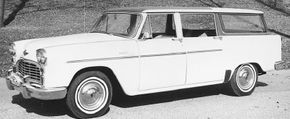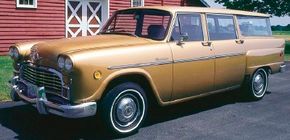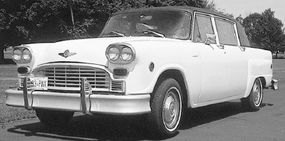Founded in 1922, Checker was long-famous for specially designed taxicabs and airport limousines when it began selling "civilian" models in 1959. Some sources say Checker offered "pleasure cars" as early as 1948, but the Kalamazoo factory always said 1959 was the first year for private sales.
Assuming one could find a Checker dealer (they were never very numerous), civilians bought what was initially called Superba, a four-door sedan or wagon in standard or Special trim. Specials were more deluxe inside, but not much. All were the same tanklike affairs familiar to anyone who ever hailed a cab from the mid-'50s to the mid-'80s. The A8 hit the streets in 1956 with a wheelbase of 120 inches -- fairly compact for the time. Average curb weights were 3400 pounds for the sedans, and nearly 3800 for the boxy wagons. Morris Markin, Checker's founder and president, was steadfast: There'd be no change to this dumpy but practical design so long as there were buyers for reliable, durable, "taxi-tough" cars. Not that there'd been many changes before. Aside from noncommercial paint jobs and leaving off the "hire light," the Superba differed from the A8 only in a front-end facelift with trendy quad headlamps.
Advertisement
Superba power came from Continental Motor Company, basically the same 226-cubic-inch L-head six once used by Kaiser (see entry). Here, though, it was available in side-valve and overhead-valve versions at no difference in price.
The former had 7.3:1 compression and produced a mere 80 horsepower, so it must have been meant for areas where gas was of very poor quality. The ohv unit had a more-modern 8:1 squeeze and a more-respectable 122 bhp. Transmissions were the expected three-speed column-shift manual and Borg-Warner automatic.
True to its taxi traditions, the Superba sedan could be equipped with a pair of rear jump seats for carrying up to eight. The wagon, which came with a roll-down tailgate window, had the same roomy back seat, which folded down to make a truly voluminous cargo deck. Unusually, though, the seat-folding was accomplished by an electric servo. This gimmick and the different bodywork made the wagon some $350 more expensive than the sedan.
At a time when mainstream American cars rolled on 14-inch wheels, Checker stuck with 15s, which made for smoother taxi rides over the increasingly cratered streets of urban America. Also reflecting its taxi origins, the Superba boasted tall doors and ruler-flat floors for easy entry/exit and plenty of foot space.
It did not, however, boast much in the way of luxury: rubber mats where carpeting might have been, pedestrian hardboard headliner, and a conspicuous absence of late-'50s safety features like padded dash and sun visors, dished steering wheel, and seatbelts. Plain round gauges nestled within a flat-faced dashboard that looked like something from a '51 Plymouth, a design that would be absolutely unchanged through the very last cars Checker built.
For more on defunct American cars, see:
- AMC
- Duesenberg
- Oldsmobile
- Plymouth
- Studebaker
- Tucker
Advertisement




